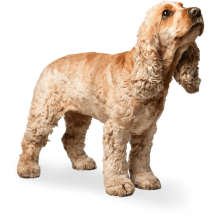

Luxating patella in dogs
It’s great to see a dog with a spring in their step, but a hop and a skip can mean something else entirely. Luxating patellas are a common knee problem in dogs, let’s explore what it means, why it matters, and what to expect.
What is a luxating patella in a dog?
The patella is the anatomical name for the kneecap. “Luxation” simply means it moves out of its normal position, also known as dislocation. When this happens, the surfaces of the joint no longer line up properly, making movement difficult and potentially painful.
The patella normally glides along a smooth groove at the bottom of the thigh bone (femur). But when that groove is too shallow, or the leg is slightly misshapen, the kneecap may slip or be pulled out of position.
In small and toy breeds, the patella usually slips inwards (medial luxation, sometimes dogs look bow-legged). In larger or giant breeds, it’s more likely to slip outwards (lateral luxation, sometimes dogs look knock-kneed). The more often this happens, the more the soft tissues stretch and the quicker the groove edge wears down, making the issue worse.
Why does that matter? The patella helps direct the force of the thigh muscles and gives them more leverage enabling more powerful movements, like jumping and running. It also helps protect the tendons and acts like a mini shield covering the front of the knee joint (stifle).
When the kneecap won’t stay put, the muscles can’t function properly, and the smooth cartilage under the kneecap and in the groove gets rubbed away, leading to inflammation and arthritis. All in all, it makes running, jumping, or even walking more difficult and uncomfortable for your dog.
Want to brush up on your pup’s joints? Here’s a guide to dog joint anatomy.

Grades of patellar luxation in dogs
Depending on how freely the patella moves and where it normally sits, patellar luxation is classified into grades:
- Grade 1: The patella only pops out of position when manually moved (during an exam or rough play), but it pops straight back.
- Grade 2: The patella occasionally slips out on its own but returns with movement – usually when the leg is fully or hyperextended.
- Grade 3: The patella is out of position most of the time but can still be pushed back into place manually.
- Grade 4: The patella is permanently out of position and cannot be moved back.
Some dogs will have both knees affected, and the severity may differ from side to side. For higher grades (3 and 4), surgery is typically the best way to preserve long-term mobility and, if caught early, prevent the bones being pulled further out of line as your dog grows. Grade 2 can occasionally benefit from surgery, but it isn’t usually recommended for grade 1.
Symptoms of patellar luxation in dogs
What you’ll notice depends on how severe the problem is. If it only happens very occasionally, your pup may not be bothered by it at all. In this case, the most common sign is a skip or hop, often followed by a kick as your pup tries to realign the kneecap by straightening the leg.
For higher grades, where the patella is stuck in the wrong place almost all the time, or as arthritis develops, other signs include:
- Intermittent limping
- Joint stiffness and pain, especially after rest
- A bow-legged or knock-kneed stance
- Difficulty jumping, climbing stairs or even simply walking
- Less willingness to exercise
Causes of patellar luxation in dogs
The patella stays in place when two things work together:
- The thigh muscles and ridge of bone on the front of the shin (tibia), where the patella attaches, are in correct alignment, creating a straight line of tension that holds the patella in its groove.
- The groove itself is deep enough to prevent the patella from wandering off course.
If your dog’s leg shape alters that line of muscle pull, or the groove is too shallow, the patella can drift or be pulled off track.
Is patellar luxation in dogs hereditary?
Yes, genetics do play a role, but it’s a complex problem. Mild issues can worsen over time (even if very slowly), and higher-grade luxations can trigger secondary problems as a young dog grows. For that reason, it’s best not to breed dogs with a patellar luxation graded 2 or above.
Some breeds are more prone to medial luxation, including Bichons, Chihuahuas, Cavaliers, Pugs, Pomeranians and more. Giant breeds are more likely to develop lateral luxation, such as Flat-coated Retrievers, Great Danes, Irish Wolfhounds, and Saint Bernards.
How to prevent patellar luxation in dogs
You can’t prevent it entirely, but you can manage it to slow progression:
- Grade 1–2 often do well with lifestyle changes, physiotherapy, weight control, dog joint health supplementation and anti-inflammatories.
- Grade 3–4 usually require surgery – sometimes while the dog is still growing – to reduce complications and preserve mobility.
The earlier you catch it, the more options you’ll have.
Should you walk a dog with a luxating patella?
That depends on the severity and your dog’s symptoms. In lower-grade luxations, or when a shallow groove is the main issue, muscle strengthening can help stabilise the patella.
Tips for safe exercise:
- Avoid high-impact activities like chasing balls, frisbees or jumping
- Stick to lead walks at a steady pace
- Manage stairs and uneven terrain: carry smaller dogs; use ramps for larger ones; go slowly on-lead
- Use grip mats indoors and avoid slippery outdoor surfaces
- Consider hydrotherapy for low-impact muscle building
For grades 3 and 4, the patella is out of position most of the time, and the knee (stifle) can’t function normally. Surgery is recommended. If that isn’t possible, remember that your dog may become stiff and sore quickly, focus on quality of life over traditional exercise:
- Use ramps and mobility aids
- Offer ultra-short walks several times a day
- Try puzzle feeders and games for mental stimulation
- Maintain strict weight control and avoid comfort feeding
With the right care, attention and lifestyle adjustments, a dog with luxating patella can lead a happy and fulfilling life, joining you for all of lives adventures.




